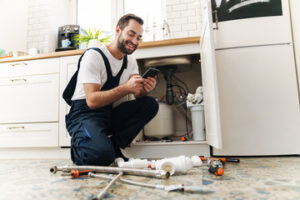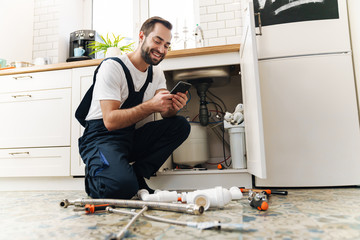Plumbing is essential for modern living, ensuring access to clean water and proper waste removal. Over time, advancements in materials and technology have transformed how plumbing systems operate. New designs and techniques improve efficiency, reduce costs, and enhance durability. These changes reflect a growing focus on sustainability and convenience.
Modern plumbing systems are designed to minimize water waste. Engineers have developed fixtures that use less water without compromising performance. Low-flow toilets and showerheads reduce consumption while maintaining pressure. This shift helps conserve resources and lower utility bills. Contact Plumbing Express, Inc. for professional help.
Smart technology has revolutionized plumbing systems. Leak detection sensors monitor water flow and alert homeowners to issues before they escalate. Automated shut-off valves prevent flooding and costly damage. These systems can be controlled remotely through mobile applications, adding convenience and peace of mind.
Material selection plays a crucial role in the longevity of plumbing systems. Corrosion-resistant pipes extend the lifespan of installations. Flexible materials simplify installation and reduce the risk of leaks. Advances in joint sealing techniques also improve overall system integrity.
Temperature control has become more efficient with modern plumbing solutions. Tankless water heaters provide hot water on demand, reducing energy consumption. Improved insulation reduces heat loss and ensures consistent water temperature. These upgrades enhance comfort while lowering energy costs.
Plumbing systems are now more adaptable to different architectural styles. Compact designs allow for easier integration into tight spaces. Hidden piping creates a cleaner, more polished look. Modular systems offer flexibility for future upgrades or repairs.
Water purification has also advanced significantly. Built-in filtration systems remove contaminants and improve water taste. UV treatment options eliminate bacteria and viruses without chemicals. These solutions provide safer drinking water directly from the tap.
Waste management has seen significant improvements in plumbing. Dual-flush systems allow users to choose between different levels of water usage. Improved drainage designs reduce the risk of clogs and backups. Septic systems now feature better aeration and filtration for enhanced performance.
Eco-friendly plumbing options are becoming more popular. Rainwater harvesting systems collect and filter water for reuse in irrigation and flushing. Greywater recycling reduces overall water consumption. These sustainable practices lower environmental impact while cutting costs.
Noise reduction is a key focus in modern plumbing design. Insulated pipes minimize sound transmission between rooms. Pressure-balancing valves reduce water hammer and maintain steady flow. These upgrades create a quieter and more comfortable living environment.
Installation methods have evolved to improve efficiency and accuracy. Pre-fabricated plumbing components reduce labor time and material waste. Push-fit connectors simplify assembly without the need for soldering or adhesive. These advancements make installations faster and more reliable.
Maintenance has become easier with modern plumbing systems. Accessible cleanouts and shut-off valves simplify repairs. Smart systems provide diagnostic data to identify issues early. Homeowners can address minor problems before they escalate into costly repairs.
The rise of sustainable building practices has influenced plumbing design. Builders incorporate water-saving fixtures and energy-efficient heating systems. Regulatory standards encourage the use of eco-friendly materials and designs. This trend reflects a broader shift toward environmentally conscious construction.
Plumbing systems are now designed to withstand extreme weather conditions. Freeze-resistant pipes prevent bursting in cold temperatures. Pressure-regulated valves protect against surges and backflow. These innovations enhance the durability and resilience of plumbing networks.
Commercial and residential plumbing systems are becoming more integrated. Centralized water management systems allow for coordinated control of multiple fixtures. Automated scheduling ensures balanced water pressure throughout the building. This level of control improves efficiency and reduces operational costs.
Water conservation has become a priority in modern plumbing. Motion-activated faucets reduce waste by turning off automatically when not in use. Greywater recycling systems capture and reuse water from sinks and showers. These solutions help reduce strain on municipal water supplies.
Advances in materials science have expanded the possibilities for plumbing design. Composite materials offer strength and flexibility while resisting corrosion. Bio-based plastics provide an environmentally friendly alternative to traditional piping. These materials improve performance and reduce environmental impact.
Smart homes now integrate plumbing with other automated systems. Leak detection and temperature control are linked to home management platforms. Users can monitor water usage and adjust settings remotely. This level of connectivity increases convenience and security.
Safety remains a top priority in plumbing system design. Anti-scald devices prevent accidental burns by regulating water temperature. Backflow preventers protect the potable water supply from contamination. These features ensure that plumbing systems meet health and safety standards.
Advanced diagnostic tools have improved the accuracy of plumbing repairs. Thermal imaging detects hidden leaks and weak points. Acoustic sensors identify the source of noise and pressure imbalances. These tools enable faster and more precise repairs.
Plumbing design now considers the aesthetics of exposed fixtures. Sleek, minimalist designs blend with modern architectural styles. Coordinated finishes create a cohesive look throughout the home. These design choices enhance both functionality and visual appeal.
Water pressure regulation has seen notable improvements. Pressure-balancing valves maintain consistent flow rates despite fluctuations in supply. Booster pumps increase pressure where needed without overloading the system. This ensures a steady and reliable water supply.
Plumbing networks are now more resistant to scale and mineral buildup. Descaling treatments extend the lifespan of pipes and fixtures. Water softening systems reduce hardness and improve overall system performance. These treatments prevent long-term damage and improve water quality.
Commercial plumbing systems benefit from increased automation. Centralized monitoring systems detect and resolve issues without human intervention. Scheduled maintenance routines improve system efficiency and longevity. This level of automation reduces operational costs and downtime.
Plumbing in multi-story buildings has become more efficient. Zoned water distribution systems balance pressure across different floors. Gravity-assisted drainage systems reduce the risk of backups and overflows. These improvements enhance overall building performance.
Greywater and blackwater treatment technologies have advanced significantly. On-site treatment systems reduce the need for external processing. Recycled water can be used for non-potable purposes, such as irrigation. These systems reduce environmental impact and improve resource efficiency.
Portable plumbing solutions are gaining popularity. Modular water supply systems allow for temporary installations in remote areas. Compact filtration systems provide clean drinking water on demand. These solutions expand access to reliable plumbing infrastructure.
Plumbing codes and standards have evolved to reflect modern practices. New guidelines encourage the use of low-impact materials and energy-efficient designs. Builders and plumbers must stay informed about these changes to ensure compliance. Adapting to these standards improves system performance and environmental impact.
Plumbing technology continues to evolve at a rapid pace. Engineers and builders collaborate to develop more efficient and sustainable solutions. The focus on water conservation, energy efficiency, and system longevity drives innovation. Modern plumbing reflects a balance of functionality, aesthetics, and environmental responsibility.
